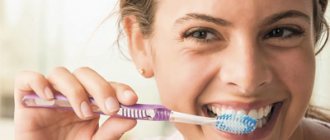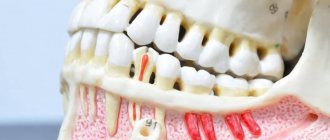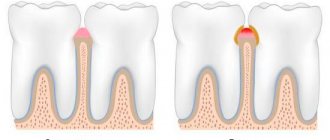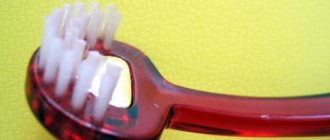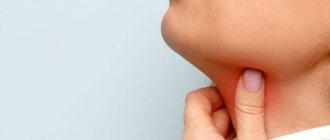Indications for the use of antibiotics in dentistry
The need for treatment with antibiotics depends on the nature of the infection and the body's ability to withstand the course. The main reasons for prescribing antibiotics include:
- When advanced caries threatens pulpitis, the dentist may prescribe antibiotics to limit the spread of the pathological process. The patient is prescribed antihistamines to complement the effectiveness of antibiotics.
- With the development of an inflammatory process of periodontal tissue (periodontitis), antibiotic therapy allows the destruction of protozoa, gram-negative anaerobes in the oral cavity. Various dosage forms of drugs are used for treatment: gels, ointments, intramuscular and intravenous injections, tablets.
- The proliferation of pathogens, poor immunity, caries and dense plaque can lead to the development of gingivitis. After laboratory detection of the sensitivity of microbes to the antibiotic, a course of treatment is prescribed. Antibiotic drugs are mainly used for catarrhal gingivitis.
- The appearance of purulent accumulations inside the oral mucosa provokes the appearance of a fistula. The process occurs due to the proliferation of anaerobic gram-negative bacteria, streptococci, staphylococci, Pseudomonas aeruginosa or Escherichia coli. A doctor-prescribed course of antibiotics, which are also used for dental implantation, will help cope with the infection.
- Inflammation of the connective tissue around the root of the tooth is called periodontitis. The occurrence of the disease is a consequence of dental trauma, a complication of pulpitis, caries, or an error in dental treatment. If the process is not stopped, pus may appear. The effectiveness of antibiotics for periodontal disease is felt after preliminary cleaning of the periodontal tissue.
- The result of inflammation of various origins can be a granuloma - a cavity of granulation tissue filled with fluid. Location: on the gum near the root of the tooth. It is important to start treating granuloma in the early stages. The use of antibiotics facilitates the opening of the granulosa vesicle and suppresses the infection accumulated in it, and serves to prevent infection. Self-medication with antibacterial drugs is unacceptable.
Types of antibiotics for toothache
Doctors use antibiotics in dentistry, which have a wide range of applications, to stop the growth and reproduction of mixed bacterial infections in the oral cavity. Drugs are divided into the following types:
Should I take an antibiotic for dental inflammation?
What to do if the gums become inflamed after the removal of a wisdom tooth, due to trauma, or with advanced caries? How to treat a complicated form of periostitis and periodontitis? The effectiveness of therapy largely depends on the selection of the optimal type of antibacterial drug to suppress the pathological process. It is useful to know when an antibiotic is prescribed for dental inflammation, which groups of drugs are most often used in dental practice.
Treatment of acute pulpitis
The above methods are ineffective in treating exacerbations of chronic pulpitis, an acute disease when the tooth becomes a source of unbearable pain radiating to the ear, temple, and back of the head. With these symptoms, endodontic treatment of pulpitis is carried out - with cleaning of the root canals and complete removal of the pulp.
In dentistry, two modern methods of treating tooth canals for pulpitis are used: devital and vital.
- Treatment of pulpitis using the vital amputation method is carried out by removing the nerve, washing, cleaning and filling the canal.
- Devital treatment of pulpitis involves the use of medicinal pastes and requires several sessions.
These treatment methods are most often used for pulpitis on permanent teeth.
How to use an antibiotic for tooth inflammation with pus
At the first stage, while the pathological process is less active, rinses with an antibacterial effect are carried out as prescribed by the dentist.
Local medications act directly on the affected area and are less absorbed into the systemic circulation, which reduces the risk of side effects.
You need to crush the tablets of Lincomycin, Azithromycin or Tetracycline, combine them with lukewarm (not hot) boiled water, and rinse your mouth with the solution. The proportions of the components are selected by the dentist.
Active inflammatory process in the periosteum and gums after removal of the problem unit, with infection from the outside or hematogenously, flux is an indication for the prescription of antimicrobial compounds. It is important to prevent complications that develop when purulent masses accumulate or exudate exits into the oral cavity through the fistula. With the flow of blood and lymph, infectious agents penetrate into other parts of the body.
Periodontitis and periostitis in acute or chronic form are dangerous diseases. To heal the wound, the dental surgeon first cleans the affected area, removes a thick mass containing pathogens, particles of blood and mucus. The second stage is the prescription of antibacterial drugs. For purulent inflammation, penicillins show high effectiveness: Amoxicillin, Amoxiclav. Depending on the severity of the pathological process, antibiotics are taken orally or given injections.
If an odontogenic infection is detected, against which the gums fester, the use of the drugs Gentamicin, Grammidin C, Ciprofloxacin, Cifran is indicated.
Why does a tooth hurt under a crown?
The exact cause of discomfort can only be determined in a dental clinic. To do this, an x-ray is taken and from the image the dentist determines the nature and location of the problem. Depending on the clinical case, he draws up a treatment plan or suggests removal.
Main reasons:
- insufficiently treated caries;
- incomplete removal of the nerve;
- the presence of empty areas due to poor obturation of root canals;
- root perforation;
- pulp burn;
- foreign bodies inside the tooth (broken parts of instruments);
- gaps between the crown and stump;
- periodontal or gum diseases;
- pathology in the roots.
Before prosthetics with ceramic, metal-ceramic or metal crowns, depulpation is usually performed. If the pulp is not removed from the tooth, then when grinding down hard tissues, it can burn and subsequently become inflamed. In another case, tissues affected by caries may remain, which will develop further, destroying the root part. Depulpation may not be done if the prosthesis has minimal thickness and the tooth preparation is superficial, far from the nerve.
If there are voids left in the root canal after filling, then they become a favorable environment for the growth of bacteria. Pulp burns occur if the dentist does not use a cooling system during grinding. Pain and symptoms of inflammation may appear after a month or even a year.
During a deputation, even an experienced doctor can make a mistake. Often the channels are thin, winding, with the finest branches. The dentist performs cleaning and filling almost blindly. In order to seal them efficiently, an expander is used. It is easy for them to damage the root walls, and even if the filling material fills the space tightly, the pain can bother you for a very long time.
It is equally difficult to install a pin into the canal. If the installation was unsuccessful, then soon a focus of inflammation appears at the site of deformation. A similar problem appears if a tool fragment remains in the root part. The endodontist uses thin devices that can easily break in difficult and curved canals. “Old” tools are especially dangerous, since cracks gradually form on them during use.
Periodontal and gum diseases ultimately lead to the destruction of the root tips with corresponding symptoms. For this reason, all pathologies are treated at the stage of preparation for prosthetics. In order to eliminate errors during endodontic treatment, modern dental clinics use a dental microscope.
Names of antibiotics used for inflammation of the dental nerve and root
The dentist prescribes medications to suppress infection based on the results of an examination of the problem area. When the nerve is inflamed, it is difficult to eat and drink; throbbing or aching pain accompanies a person throughout the day and intensifies at night.
Before starting therapy, the doctor conducts an allergy test and interviews the patient to identify contraindications.
Antibiotics help eliminate inflammation of the root and dental nerve:
- Ciprofloxacin.
- Azithromycin.
- Amoxiclav.
- Azithromycin.
- Ampiox.
- Doxycycline.
- Digital
Symptoms of pulpitis
- monotonous and aching pain at the initial stage of the disease,
- very strong and acute pain, which worsens closer to night. Unlike ordinary caries, the pain does not decrease, even if the irritant is removed, i.e. stop eating, drinking or brushing your teeth,
- reaction to temperature stimuli - hot and cold, and quite strong and pronounced,
- pain and acute reaction when tapping on the tooth.
Pulpitis is quite difficult to confuse with other diseases precisely because of the specific pain that accompanies the acute course of the disease. As a rule, black carious spots are present on the tooth at the same time, including they can be located under the filling (in this case it becomes dark), as well as under the crown (if the nerve has not been removed, however, in such a situation, carious inflammation will not be visible) .
List of effective antibacterial agents for dental infections under the crown
After endoprosthetics and implant installation, some patients complain of discomfort. Pain and inflammation are a consequence of a violation of the technology for fixing artificial teeth and crowns: the dentist did not completely fill the cavity inside the problem unit or mechanical damage to the canal walls occurred. If the implantologist is poorly qualified, the pin may be installed incorrectly. Perhaps the smallest parts from dental instruments remain inside the canal.
There are several causes of the pathological process and pain syndrome:
- swollen gums or gumboil (acute inflammation);
- cyst - a cavity with fluid near the root of a problematic unit of the dentition;
- inflammation of the submandibular salivary glands;
- dental granuloma;
- a fistula on the gum is a hole through which purulent masses are released.
With the development of inflammation in periodontal tissues, an abscess forms at the root apex. Painful sensations are a consequence of the active accumulation of exudate and pressure on neighboring areas.
The main condition for eliminating discomfort is a timely visit to the dentist to remove the crown, clean the root canals, and eliminate the cause of the inflammatory process. Uncontrolled use of antibiotics can harm the body.
Before treating the canals, the doctor makes an injection into the gum, removes the prosthesis, and examines the affected area.
Effective antibiotics are prescribed to suppress the infection:
After the removal of a wisdom tooth, there is an increased risk of not only inflammation, but also bleeding from the socket.
If the patient takes the drug Warfarin to prevent thrombosis, then you need to warn the dentist: the doctor temporarily stops taking the medication for several days before and after the extraction of the “eight”, be sure to coordinate this action with the cardiologist.
It is important to know how to combine an antithrombotic agent with antimicrobial compounds.
Complications of pulpitis
If you do not consult a dentist in a timely manner, pulpitis can develop into a more serious disease - periodontitis, cyst or granuloma, periostitis. That is, the inflammation will go deeper and go beyond the tooth root. Such complications can lead to tooth extraction, after which neighboring teeth will begin to shift, leading to malocclusion. Since the disease causes some discomfort while chewing food, the patient may face serious gastrointestinal problems.
The use of antibiotic therapy during pregnancy and lactation
Most antimicrobial agents are prohibited for use by expectant mothers and during breastfeeding. When prescribing antibiotics to suppress the purulent-inflammatory process in the gums and periosteum, the doctor takes into account the benefits for the woman and the possible risk for the developing fetus.
With the active spread of infection, suppuration, development of sepsis, severe complications against the background of the pathological process, it is possible to take certain groups of antibacterial agents. The new generation of antibiotics is less toxic to the fetus.
Under strict medical supervision, in the minimum effective dose, the following is prescribed:
- Ornidazole;
- Metronidazole;
- Josamycin;
- Azithromycin;
- Clarithromycin;
- Clindamycin;
- Cefepime;
- Ceftaroline.
The list of approved drugs is indicated by the dentist. The best option is to additionally consult with a gynecologist managing the pregnancy.
Anti-tuberculosis antibiotics are allowed to be used by pregnant women in combination with other drugs according to a specific regimen for a long period.
Contraindications to treatment with antibacterial drugs
Compositions for suppressing the inflammatory process in gingival and bone tissue during toothache are not suitable for all patients. Restrictions for use are related to age, body reactions, and special conditions. Most antibacterial drugs should not be used by nursing mothers or pregnant women.
Main contraindications for antibiotic therapy:
- allergic reactions;
- liver and kidney failure;
- intolerance to the active substance: you need to choose a substitute with another active ingredient;
- myasthenia gravis;
- damage to the optic nerve;
- severe diseases of the gastrointestinal tract;
- the patient is taking medications that are incompatible with a certain group of antibiotics;
- tendinitis;
- epilepsy;
- children's age (restrictions are indicated in the instructions for the drug).
A limited range of antibacterial compounds are used in pediatric practice.
It is important to clarify in the instructions the age of the child for safe antibiotic therapy for acute inflammation of tissues in the oral cavity.
In case of purulent inflammation, the development of periostitis and periodontitis, when the gums are swollen, the dentist selects effective antibacterial compounds. Many inexpensive antibiotics work well for dental inflammation and quickly suppress the pathological process. New generation drugs with a minimal list of contraindications and side effects are safer.
Antibiotics for toothache.
Many people consider antibiotics a panacea for all ills and, at the first problem with their teeth, begin to take them intensively. However, such self-medication can cause irreparable harm to other organs and systems of the body, without improving the condition of the teeth. Prescribing antibiotics is the exclusive prerogative of the doctor. In what cases are these medications prescribed?
The use of antibiotics in modern dental practice is necessary today, because... Despite the development of dentistry, the number of patients with foci of acute and chronic inflammatory processes in the maxillofacial area and oral cavity is not decreasing, so the prescription of antibiotics in dental practice today is completely inevitable. Every day, a dentist is faced with situations when it is necessary to decide on antibacterial therapy: this is an exacerbation of chronic periodontitis, abscess formation of inflammatory periodontal diseases and endodontic-periodontal lesions. In addition, the need to use antibacterial drugs in dentistry is also dictated by the fact that any dental procedure is accompanied by the risk of bacteremia, which is of little importance for somatically healthy patients, but dangerous for people weakened by intercurrent diseases and the presence of conditions for local colonization of pathogenic microorganisms. Thus, when the endodontic instrument extends beyond the apex by 2 mm during canal treatment, bacteremia is detected in 54% of patients. If the canal is treated with a distance of 1 mm from the apex, bacteremia is detected in 31% of patients, and in the vast majority of cases anaerobic microflora is detected. Bacteria that enter the blood of healthy people are destroyed within 10 minutes due to immune defense factors, and bacteremia is transient [6], while for patients with somatic diseases, people taking drugs, alcohol, steroids, whose immune response is reduced or absent , bacteremia can pose a real danger.
Thus, in dental practice, antibiotics are used in the following clinical situations:
- In the treatment of acute and exacerbation of chronic purulent-inflammatory processes in the maxillofacial area: odontogenic inflammatory processes, incl. periostitis, osteomyelitis, pericoronaritis, sinusitis, abscesses and phlegmon, severe infectious diseases of the oral cavity; for inflammatory periodontal diseases.
- For the prevention of postoperative infectious complications.
Thus, the prescription of antibiotics in dental practice can be aimed at preventing infectious complications (antibiotic prophylaxis) and eliminating the existing inflammatory process (antibiotic therapy). The need for antibiotic prophylaxis is associated with the existing statistics of infectious complications of dental operations: thus, according to research results, the incidence of such complications is 3.3% for “clean” wounds, 10.8% for conditionally “clean” wounds, 16.3% for contaminated wounds , 28.6% – for “dirty” wounds [14]. Antibiotic prophylaxis refers to the use of antibiotics to prevent microbial colonization and reduce the risk of postoperative complications. The administration of the antimicrobial drug must be carried out no earlier than an hour and no later than 30 minutes before surgery, i.e. to bacterial contamination of tissues. The goal of antibiotic prophylaxis is to create an effective concentration of the drug in tissues throughout the entire operation and during the first 3-4 hours after surgery. The effective concentration of the antibiotic in the surgical wound must be maintained throughout the entire operation and, most importantly, maintained at the time of suturing, when microbial contamination reaches its maximum. As part of antibiotic prophylaxis, continued administration of an antibiotic after surgery for longer than 24 hours is undesirable, as it negatively affects the dynamics of the inflammatory response, leads to the growth of resistant strains, adverse drug reactions, additional costs and often does not lead to increased effectiveness in the prevention of infectious complications . On the other hand, administering antibiotics after surgery is ineffective. Antibiotic prophylaxis started after the “critical period” is considered late, and according to some data [11], has no effect at all.
Principles of antibiotic prophylaxis:
The benefit of prophylactic use of an antibiotic outweighs the risk of side effects, superinfection and the development of resistant strains.
The choice of drug for antibiotic prophylaxis must be made taking into account the most likely pathogen.
The antimicrobial drug must reach the site of action before microorganisms enter there.
The antibiotic concentration must be maintained throughout the entire period of possible contamination of the operating area.
Indications for antibiotic therapy [2, 4, 5]:
- Increase in temperature, disturbance in general condition.
- A history of diseases such as rheumatism, endocarditis, uveitis, iridocyclitis.
- The patient has transplanted organs and foreign bodies (stents, prosthetic valves and joints).
These indications must be taken into account when choosing chemotherapeutic drugs during endodontic treatment and treatment of inflammatory periodontal diseases.
In modern dental practice, the following groups of antibiotics are most common [1, 7, 8]:
- penicillins (amoxicillin, co-amoxiclav) – first-line drugs;
- lincomycin - an antibiotic used for abscess formation;
- fluoroquinolones: ciprofloxacin, ofloxacin. These drugs are effective in the most severe cases during periodontal treatment when Aggregatibacter actinomycetemcomitans-associated periodontitis is detected, especially in patients with concomitant diabetes mellitus [3].
In recent years, along with a significant increase in the number of patients with purulent-inflammatory processes, there has been an increasingly widespread distribution of microorganisms with natural and acquired resistance to antibiotics, and the situation is often complicated by the fact that several pathogenic microorganisms are involved in the development of the inflammatory process. The difficulty of choosing a drug for antibiotic therapy in the treatment of purulent-inflammatory processes is due to the presence at the site of infection of various groups of aerobic and anaerobic pathogens that differ significantly in sensitivity to antibiotics. Therefore, the goal of rational antibiotic therapy is to select an effective antibacterial drug and its dose, which allows creating the necessary concentration of the active substance in the tissues to suppress the growth of pathogenic bacteria. For effective treatment of patients with purulent-inflammatory processes, there is a need for the combined use of antibiotics or drugs that include antibacterial substances that act on different groups of pathogens. These requirements are met by the combination drug Ciprolet A (A means effectiveness against anaerobes), the effect of which is due to the components included in its composition: ciprofloxacin 500 mg and tinidazole 600 mg.
Ciprofloxacin is a broad-spectrum antimicrobial agent, a fluoroquinolone derivative that affects gram-positive and gram-negative bacilli and cocci, Staphylococcus aureus, viridans streptococcus, Haemophilus influenzae, Escherichia coli, Pseudomonas aeruginosa.
Tinidazole is an antiprotozoal and antimicrobial agent, an imidazole derivative. Tinidazole is similar in structure and action to metronidazole. The activity of tinidazole is 1.5 times greater than that of metronidazole against anaerobes, which is successfully used when pathogen resistance to metronidazole is established.
The action spectra of ciprofloxacin and tinidazole ensure the high effectiveness of Ciprolet A against a wide range of pathogens, gram-positive, gram-negative aerobes and anaerobes. Resistance to it develops extremely slowly: bacterial cells do not have enzymes that inactivate it, and there are practically no persistent microorganisms left.
The undoubted advantage of the antibacterial drug Tsiprolet A is the frequency of administration (2 times a day), while for co-amoxiclav the frequency of administration is 2–3 times, and for lincomycin and metronidazole – 3 times a day. A very unpleasant side effect of antibiotic therapy is antibiotic-associated diarrhea [12, 13]. For Tsiprolet A, the probability of this side effect occurring is less than 1%, while for lincomycin it is 20–30, and for co-amoxiclav it is 10–25%. This is due to the activity of Tsiprolet A against Clostridium difficile [10]. The most important indicator that determines the effectiveness of an antibiotic in inflammatory diseases of the maxillofacial area is its ability to penetrate bone tissue. For Tsiprolet A, this figure is 0.27–1.20, which is twice as high as the same figure for co-amoxiclav and three times higher than for lincomycin [9].
Indications for use of the drug Tsiprolet A: infections of the ENT organs (otitis media, sinusitis, tonsillitis, pharyngitis); infectious and inflammatory processes of the oral cavity; infections of the skin and soft tissues (infected ulcers, wounds, burns, abscesses, cellulitis, ulcerative skin lesions); infections of bones and joints (osteomyelitis, septic arthritis); postoperative infections. Indications for use are related to the fact that its therapeutic concentrations are created, incl. in saliva, tonsils, lung tissue, bronchial secretions, bone tissue, muscles, synovial fluid, articular cartilage and skin, i.e. in all organs and tissues located in the oral cavity, maxillofacial and adjacent areas.
Such a wide range of application and high effectiveness of Tsiprolet A in the treatment of purulent processes in the maxillofacial area are due to the unique spectrum of antimicrobial activity of the drug: Tsiprolet A is active against the Enterobacteriaceae spp. family, which plays a key role in the development of severe purulent lesions in dentistry. Lincomycin, clarithromycin and metronidazole have no effect on these microorganisms. Tsiprolet A is effective against microorganisms that are also not affected by clarithromycin. This is Peptostreptococcus spp. and Fusobacterium spp. – anaerobic bacteria that contribute to the progression and spread of odontogenic infection [8, 9].
When prescribing Tsiprolet A, it is necessary to inform the patient that tinidazole, which is part of the drug, is not compatible with alcohol, because causes disulfiram-like reactions in the form of skin hyperemia, tachycardia, nausea, vomiting, etc., therefore, it is not recommended to take alcoholic beverages during the treatment period.
The wide spectrum of antimicrobial activity of the combined drug Tsiprolet A, the rapid creation of therapeutic concentrations in the organs and tissues of the oral cavity and maxillofacial area allow us to recommend it for wide use in dental practice.
Are antibiotics effective?
Before starting a course of antibiotics, you should determine the cause of your toothache. There are two main factors that provoke it:
- Caries that has developed to pulpitis. When the carious process affects the nerve, the tooth begins to react to various irritants: sour, sweet, cold, hot. Since in this case the pain is provoked by an intradental inflammatory process, antibiotics will be completely useless. For such pain, anti-inflammatory drugs, for example, Ibuprofen, are relevant. In addition to drug treatment, it is also planned to remove the affected tissue and fill the dental canals.
- An infection localized in a “dead” tooth. In such a situation, after removal of the nerve, the tooth does not react to sour, sweet and other irritants, but at the same time it hurts - and more and more every day. It's all about microbes that multiply either in an unfilled canal or in some tiny crack in the root. As a result, a purulent abscess or gumboil develops near the root of the tooth. The latter, by the way, is deadly. If such inflammation of the tooth root occurs, antibiotics are prescribed, but before taking them the patient will have to undergo the procedure of opening the abscess.
Before pinning any hopes on antibiotics, you should understand a few facts about this group of drugs:
- antibiotics help in treating the disease that provokes toothache, and do not relieve the pain itself (there are analgesics for this purpose);
- different antibiotics have different effects on pathogens, so it is almost impossible to successfully select such a medicine on your own;
- the effectiveness of taking antibiotics without concomitant dental treatment tends to zero.
The course of antibiotic treatment should not be interrupted prematurely: incomplete therapy will not lead to the desired result.
Treatment at the dentist
The doctor begins treatment by washing the socket and treating it with antiseptic solutions, and then cleans the socket from the remains of the blood clot using a surgical curette. Then the wound is dried with a gauze swab and treated with an anesthetic and antibacterial agents. The wound is covered with a bandage, which is designed to protect the open surface of the wound from possible biological, chemical or mechanical irritants. To check the possibility of detecting pieces of the extracted tooth in the socket, an x-ray can first be taken.
The procedure for cleaning the hole as a whole is carried out according to the following scheme:
- Local anesthesia is performed;
- The well is washed with an antiseptic solution (hydrogen peroxide solution 3%, chlorhexidine 0.05% or furatsilin 0.02%), and food debris and necrotic masses are removed;
- If there are foreign bodies in the hole (root fragments, cysts and granulomas), they are removed using special instruments;
- After cleaning the hole, it is treated with antiseptic solutions, dried with a sterile gauze swab, and turunda with an antiseptic and an anesthetic is injected into it. With a mild degree of inflammation, a turunda may not be necessary; thorough cleansing of the hole and subsequent care for it is sufficient;
- In case of a pronounced necrotic process in the hole, rinsing and application with trypsin is carried out - this is an enzyme preparation that accelerates the breakdown of dead tissue. Trypsin has anti-inflammatory and anti-edematous effects, helps clean the socket from necrotic masses and pus;
- After completing all the manipulations, the patient goes home, the doctor appoints appointment days when he needs to come for antiseptic treatment of the hole and change the turunda, if one has been installed. If necessary, a course of antibiotics is prescribed.
For alveolitis, antiseptic baths (not rinsing) with solutions of chlorhexidine 0.05% or miramistin 0.01%, which can be purchased ready-made at the pharmacy, are effective. When performing baths, the solution is taken into the mouth and held for several minutes, then carefully spat out. To relieve pain and reduce the degree of inflammation, nimesulide or ibuprofen are prescribed.
To prevent the turunda from falling out of the socket, during treatment you need to eat soft, pureed food and do not chew on the sore side. If the turunda does fall out, you need to rinse your mouth with chlorhexidine solution and immediately consult a doctor.
If this is not possible, you should rinse the hole yourself from food debris: to do this, bite off the sharp tip of the needle from a 5 ml syringe, bend it a little, and disinfect it with pure alcohol. A chlorhexidine solution is drawn into the syringe, the needle is inserted into the hole (not too deep) and the piston is pressed intensely to create a liquid pressure that can remove food debris.
All cases of alveolitis treatment are individual, so it may be necessary to visit the dentist up to several times.
With a favorable course of the healing process, the pain goes away, and the inflammatory process gradually subsides and disappears after a few days.
If the process, despite the procedures performed, progresses, then after antiseptics, gauze tampons soaked in propolis tincture or camvorophenol solution (10%) are inserted into the hole. A tetracycline-prednisolone cone inserted into the well has a good antibacterial effect.
